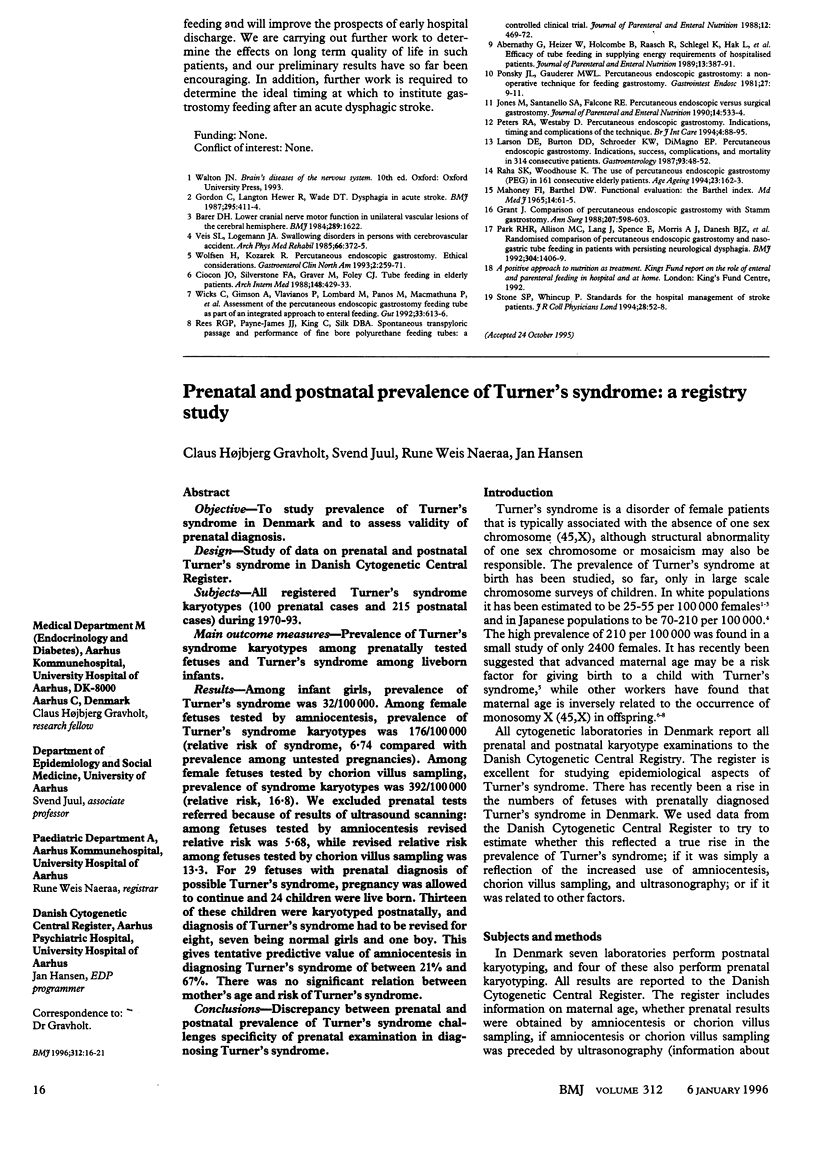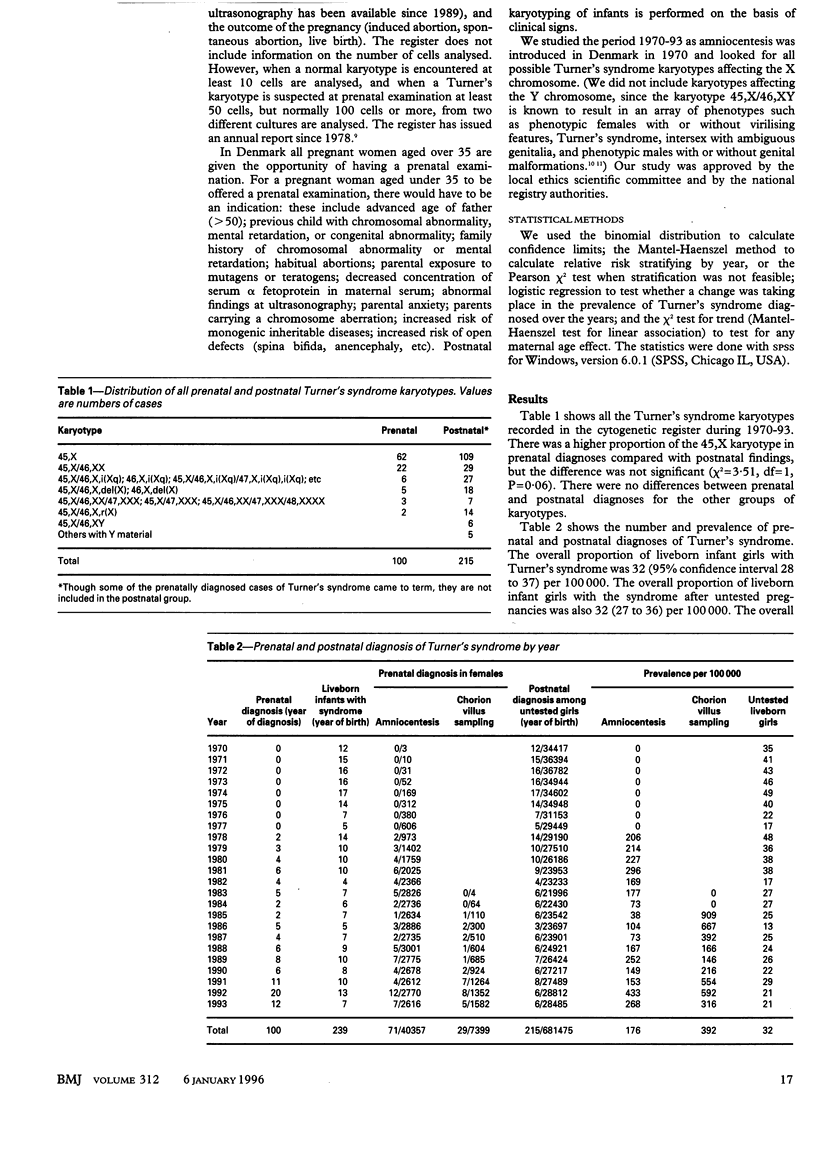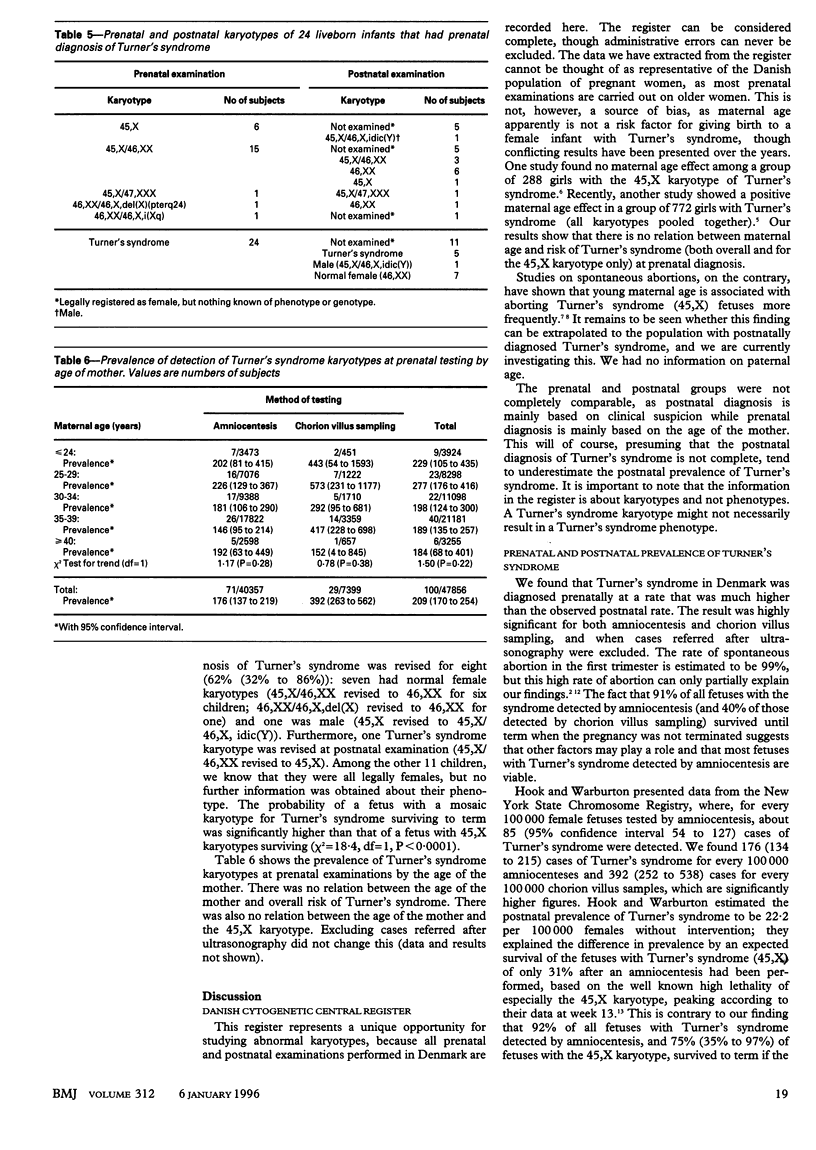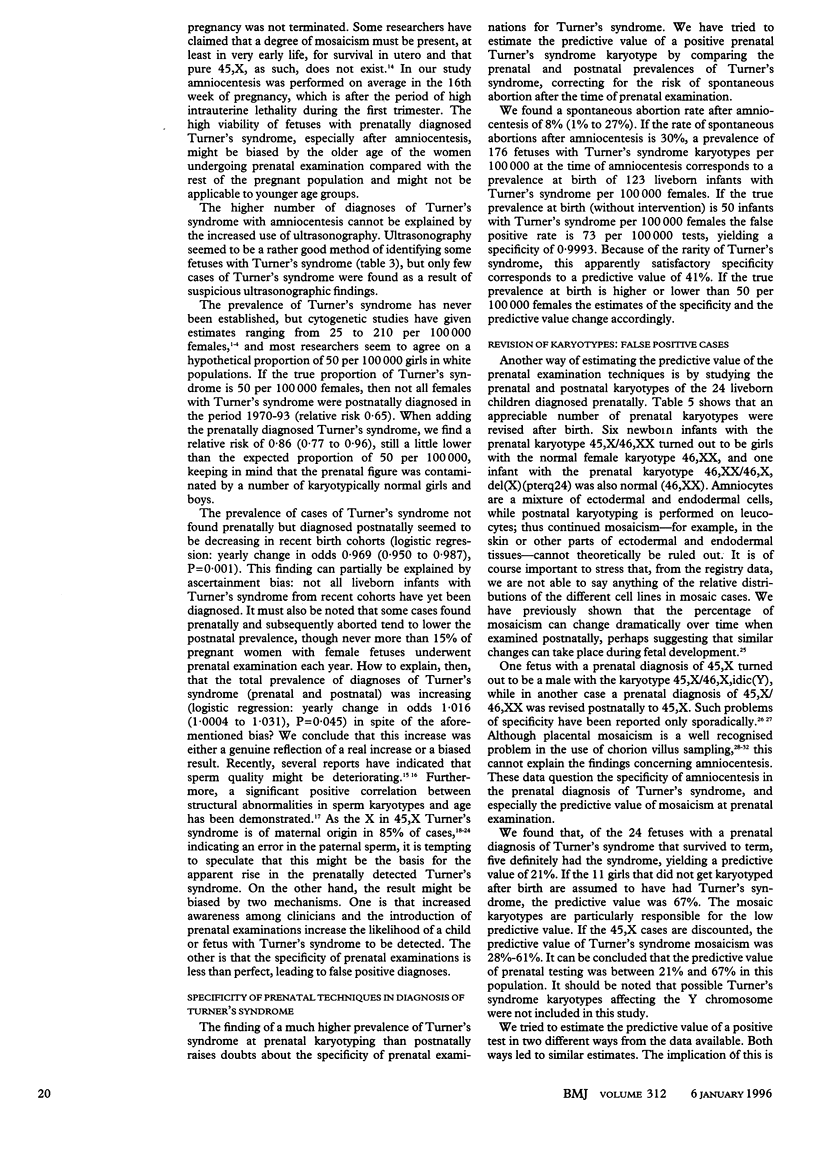Abstract
OBJECTIVE--To study prevalence of Turner's syndrome in Denmark and to assess validity of prenatal diagnosis. DESIGN--Study of data on prenatal and postnatal Turner's syndrome in Danish Cytogenetic Central Register. SUBJECTS--All registered Turner's syndrome karyotypes (100 prenatal cases and 215 postnatal cases) during 1970-93. MAIN OUTCOME MEASURES--Prevalence of Turner's syndrome karyotypes among prenatally tested fetuses and Turner's syndrome among liveborn infants. RESULTS--Among infant girls, prevalence of Turner's syndrome was 32/100,000. Among female fetuses tested by amniocentesis, prevalence of Turner's syndrome karyotypes was 176/100,000 (relative risk of syndrome, 6.74 compared with prevalence among untested pregnancies). Among female fetuses tested by chorion villus sampling, prevalence of syndrome karyotypes was 392/100,000 (relative risk, 16.8). We excluded prenatal tests referred because of results of ultrasound scanning: among fetuses tested by amniocentesis revised relative risk was 5.68, while revised relative risk among fetuses tested by chorion villus sampling was 13.3. For 29 fetuses with prenatal diagnosis of possible Turner's syndrome, pregnancy was allowed to continue and 24 children were live born. Thirteen of these children were karyotyped postnatally, and diagnosis of Turner's syndrome had to be revised for eight, seven being normal girls and one boy. This gives tentative predictive value of amniocentesis in diagnosing Turner's syndrome of between 21% and 67%. There was no significant relation between mother's age and risk of Turner's syndrome. CONCLUSIONS--Discrepancy between prenatal and postnatal prevalence of Turner's syndrome challenges specificity of prenatal examination in diagnosing Turner's syndrome.
Full text
PDF





Selected References
These references are in PubMed. This may not be the complete list of references from this article.
- Bernasconi S., Larizza D., Benso L., Volta C., Vannelli S., Milani S., Aicardi G., Berardi R., Borrelli P., Boscherini B. Turner's syndrome in Italy: familial characteristics, neonatal data, standards for birth weight and for height and weight from infancy to adulthood. Acta Paediatr. 1994 Mar;83(3):292–298. doi: 10.1111/j.1651-2227.1994.tb18097.x. [DOI] [PubMed] [Google Scholar]
- Carlsen E., Giwercman A., Keiding N., Skakkebaek N. E. Evidence for decreasing quality of semen during past 50 years. BMJ. 1992 Sep 12;305(6854):609–613. doi: 10.1136/bmj.305.6854.609. [DOI] [PMC free article] [PubMed] [Google Scholar]
- Carothers A. D., Frackiewicz A., De Mey R., Collyer S., Polani P. E., Osztovics M., Horváth K., Papp Z., May H. M., Ferguson-Smith M. A. A collaborative study of the aetiology of Turner syndrome. Ann Hum Genet. 1980 May;43(4):355–368. doi: 10.1111/j.1469-1809.1980.tb01570.x. [DOI] [PubMed] [Google Scholar]
- Chang H. J., Clark R. D., Bachman H. The phenotype of 45,X/46,XY mosaicism: an analysis of 92 prenatally diagnosed cases. Am J Hum Genet. 1990 Jan;46(1):156–167. [PMC free article] [PubMed] [Google Scholar]
- Connor J. M., Loughlin S. A. Molecular genetics of Turner's syndrome. Acta Paediatr Scand Suppl. 1989;356:77–81. doi: 10.1111/j.1651-2227.1989.tb11251.x. [DOI] [PubMed] [Google Scholar]
- Gravholt C. H., Friedrich U., Nielsen J. Chromosomal mosaicism: a follow-up study of 39 unselected children found at birth. Hum Genet. 1991 Nov;88(1):49–52. doi: 10.1007/BF00204928. [DOI] [PubMed] [Google Scholar]
- Hassold T., Benham F., Leppert M. Cytogenetic and molecular analysis of sex-chromosome monosomy. Am J Hum Genet. 1988 Apr;42(4):534–541. [PMC free article] [PubMed] [Google Scholar]
- Held K. R., Kerber S., Kaminsky E., Singh S., Goetz P., Seemanova E., Goedde H. W. Mosaicism in 45,X Turner syndrome: does survival in early pregnancy depend on the presence of two sex chromosomes? Hum Genet. 1992 Jan;88(3):288–294. doi: 10.1007/BF00197261. [DOI] [PubMed] [Google Scholar]
- Hook E. B., Topol B. B., Cross P. K. The natural history of cytogenetically abnormal fetuses detected at midtrimester amniocentesis which are not terminated electively: new data and estimates of the excess and relative risk of late fetal death associated with 47,+21 and some other abnormal karyotypes. Am J Hum Genet. 1989 Dec;45(6):855–861. [PMC free article] [PubMed] [Google Scholar]
- Hook E. B., Warburton D. The distribution of chromosomal genotypes associated with Turner's syndrome: livebirth prevalence rates and evidence for diminished fetal mortality and severity in genotypes associated with structural X abnormalities or mosaicism. Hum Genet. 1983;64(1):24–27. doi: 10.1007/BF00289473. [DOI] [PubMed] [Google Scholar]
- Jacobs P. A., Betts P. R., Cockwell A. E., Crolla J. A., Mackenzie M. J., Robinson D. O., Youings S. A. A cytogenetic and molecular reappraisal of a series of patients with Turner's syndrome. Ann Hum Genet. 1990 Jul;54(Pt 3):209–223. doi: 10.1111/j.1469-1809.1990.tb00379.x. [DOI] [PubMed] [Google Scholar]
- Jacobs P. A., Melville M., Ratcliffe S., Keay A. J., Syme J. A cytogenetic survey of 11,680 newborn infants. Ann Hum Genet. 1974 May;37(4):359–376. doi: 10.1111/j.1469-1809.1974.tb01843.x. [DOI] [PubMed] [Google Scholar]
- Kajii T., Ohama K. Inverse maternal age effect in monosomy X. Hum Genet. 1979 Oct 1;51(2):147–151. doi: 10.1007/BF00287168. [DOI] [PubMed] [Google Scholar]
- Keiding N., Giwercman A., Carlsen E., Skakkebaek N. E. Falling sperm quality. BMJ. 1994 Jul 9;309(6947):131–131. doi: 10.1136/bmj.309.6947.131b. [DOI] [PMC free article] [PubMed] [Google Scholar]
- Kulkarni R., Hawkins J., Bradford W. P. Prenatal diagnosis of 45,X/46,XX mosaicism in the fetus. Should the pregnancy be terminated? Prenat Diagn. 1989 Jun;9(6):439–441. doi: 10.1002/pd.1970090610. [DOI] [PubMed] [Google Scholar]
- Larsen T., Gravholt C. H., Tillebeck A., Larsen H., Jensen M. B., Nielsen J., Friedrich U. Parental origin of the X chromosome, X chromosome mosaicism and screening for "hidden" Y chromosome in 45,X Turner syndrome ascertained cytogenetically. Clin Genet. 1995 Jul;48(1):6–11. doi: 10.1111/j.1399-0004.1995.tb04046.x. [DOI] [PubMed] [Google Scholar]
- Lippe B. Turner syndrome. Endocrinol Metab Clin North Am. 1991 Mar;20(1):121–152. [PubMed] [Google Scholar]
- Lorda-Sanchez I., Binkert F., Maechler M., Schinzel A. Molecular study of 45,X conceptuses: correlation with clinical findings. Am J Med Genet. 1992 Feb 15;42(4):487–490. doi: 10.1002/ajmg.1320420414. [DOI] [PubMed] [Google Scholar]
- Loughlin S. A., Redha A., McIver J., Boyd E., Carothers A., Connor J. M. Analysis of the origin of Turner's syndrome using polymorphic DNA probes. J Med Genet. 1991 Mar;28(3):156–158. doi: 10.1136/jmg.28.3.156. [DOI] [PMC free article] [PubMed] [Google Scholar]
- Martin R. H., Rademaker A. W. The effect of age on the frequency of sperm chromosomal abnormalities in normal men. Am J Hum Genet. 1987 Sep;41(3):484–492. [PMC free article] [PubMed] [Google Scholar]
- Miny P., Hammer P., Gerlach B., Tercanli S., Horst J., Holzgreve W., Eiben B. Mosaicism and accuracy of prenatal cytogenetic diagnoses after chorionic villus sampling and placental biopsies. Prenat Diagn. 1991 Aug;11(8):581–589. doi: 10.1002/pd.1970110815. [DOI] [PubMed] [Google Scholar]
- Nielsen J., Wohlert M. Chromosome abnormalities found among 34,910 newborn children: results from a 13-year incidence study in Arhus, Denmark. Hum Genet. 1991 May;87(1):81–83. doi: 10.1007/BF01213097. [DOI] [PubMed] [Google Scholar]
- Nisani R., Chemke J., Voss R., Appelman Z., Caspi B., Lewin A., Dar H., Reiter A. The dilemma of chromosomal mosaicism in chorionic villus sampling--'direct' versus long-term cultures. Prenat Diagn. 1989 Apr;9(4):223–226. doi: 10.1002/pd.1970090402. [DOI] [PubMed] [Google Scholar]
- Roland B., Cox D. M., Rudd N. L. Sex chromosome mosaicism not detected at amniocentesis. Prenat Diagn. 1990 May;10(5):333–336. doi: 10.1002/pd.1970100509. [DOI] [PubMed] [Google Scholar]
- Schwinger E., Seidl E., Klink F., Rehder H. Chromosome mosaicism of the placenta--a cause of developmental failure of the fetus? Prenat Diagn. 1989 Sep;9(9):639–647. doi: 10.1002/pd.1970090907. [DOI] [PubMed] [Google Scholar]
- Tharapel A. T., Elias S., Shulman L. P., Seely L., Emerson D. S., Simpson J. L. Resorbed co-twin as an explanation for discrepant chorionic villus results: non-mosaic 47,XX,+16 in villi (direct and culture) with normal (46,XX) amniotic fluid and neonatal blood. Prenat Diagn. 1989 Jul;9(7):467–472. doi: 10.1002/pd.1970090703. [DOI] [PubMed] [Google Scholar]
- Tomkins D. J., Vekemans M. J. False-positive and false-negative cytogenetic findings on chorionic villus sampling. Prenat Diagn. 1989 Feb;9(2):139–140. doi: 10.1002/pd.1970090210. [DOI] [PubMed] [Google Scholar]
- Villamar M., Fernandez E., Ayuso C., Ramos C., Benitez J. Study of the parental origin of sexual aneuploidy in ten families using RFLPs. Ann Genet. 1990;33(1):29–31. [PubMed] [Google Scholar]
- Warburton D., Kline J., Stein Z., Susser M. Monosomy X: a chromosomal anomaly associated with young maternal age. Lancet. 1980 Jan 26;1(8161):167–169. doi: 10.1016/s0140-6736(80)90658-3. [DOI] [PubMed] [Google Scholar]
- Wheeler M., Peakman D., Robinson A., Henry G. 45,X/46,XY mosaicism: contrast of prenatal and postnatal diagnosis. Am J Med Genet. 1988 Mar;29(3):565–571. doi: 10.1002/ajmg.1320290314. [DOI] [PubMed] [Google Scholar]


